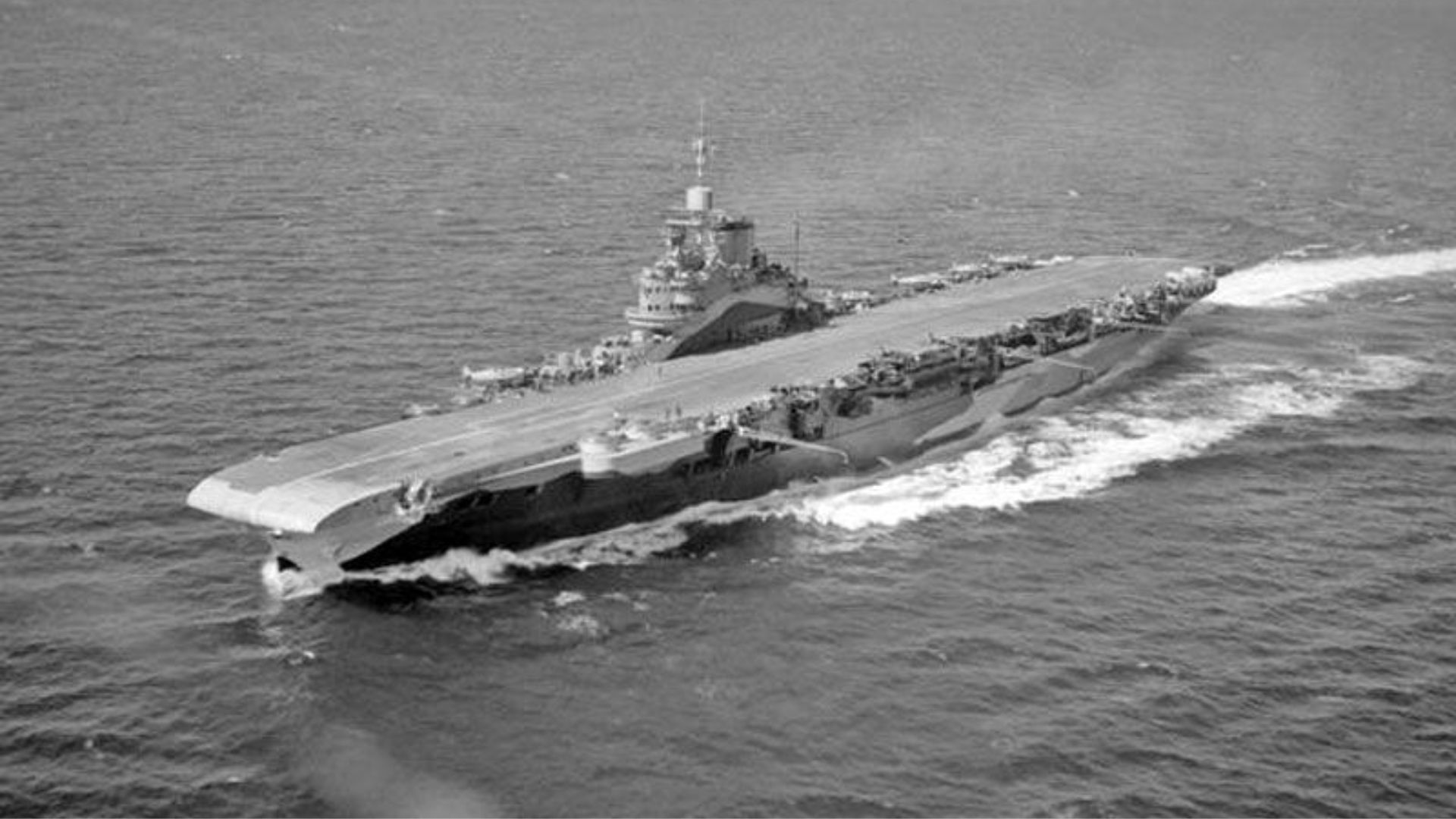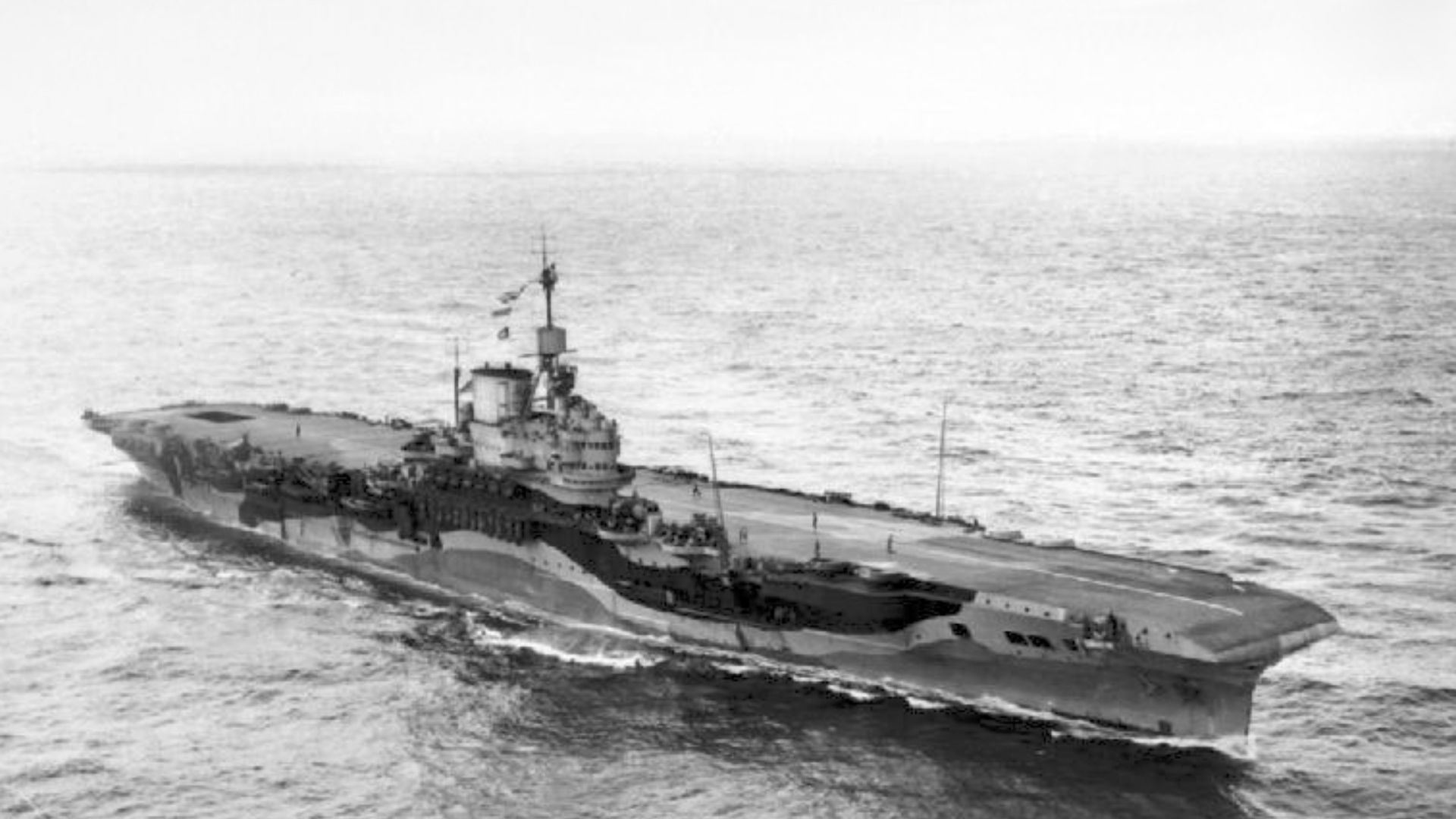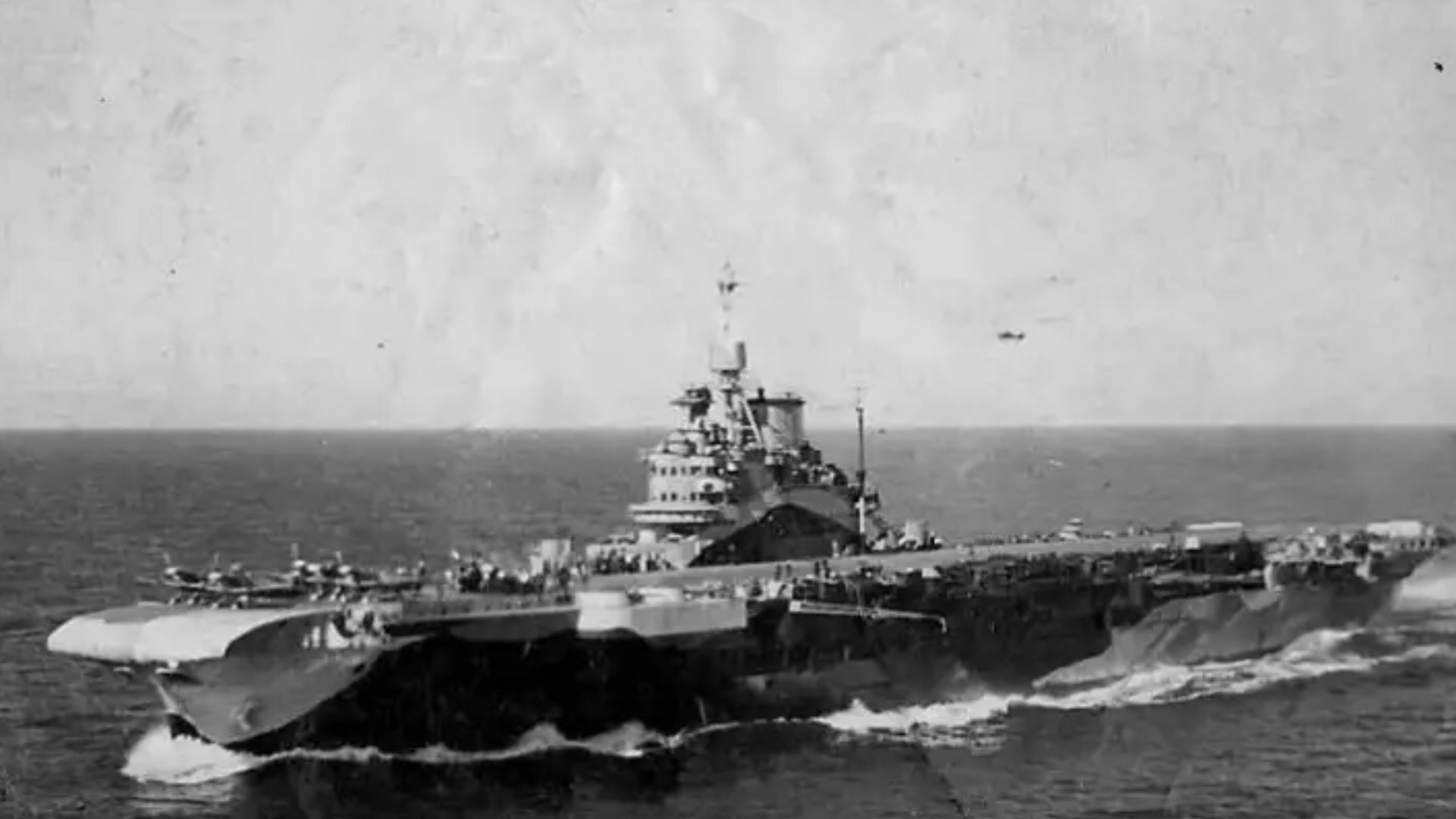
During World War II, the Royal Navy operated the illustrious class aircraft carrier HMS Formidable. Built by Belfast's Harland & Wolff, she was launched on August 17, 1939. Just prior to the start of the launch ceremony, there was a mishap - the ship's wooden cradle gave way, causing it to slide down the launchway while the workers were still below and surrounding it.
At least twenty spectators were hurt, and one spectator died as a result of flying debris. However, Formidable remained undamaged. The incident led to Formidable being dubbed "The Ship That Launched Herself." Her commissioning date was November 24, 1940.
In this article, we will explore the intriguing history of HMS Formidable (67), detailing its design, development, and significant events that shaped its service during World War II. This battleship was at the forefront of significant naval actions, taking part in the Battle of Cape Matapan and playing a vital role in the Allied invasion of North Africa and the Mediterranean.
Background And Description Of HMS Formidable 67
The inception of the Illustrious-class aircraft carriers within the Royal Navy's 1936 Naval Programme marked a significant evolution in naval warfare. The Third Sea Lord and Controller of the Navy, Admiral Sir Reginald Henderson, developed the innovative strategy that gave rise to these carriers.
Henderson understood that enemy attacks, especially from land-based aircraft in limited areas such as the North and Mediterranean Seas, might target the traditional unarmored carrier designs, such as the Ark Royal.
Henderson pushed on a dramatic break from the past in order to overcome these weaknesses. In his opinion, ships need solid defenses and an early-warning system to save their fragile aircraft.
This resulted in the choice to fully arm the hangar, guaranteeing the security of the aircraft within, however, owing to stability issues, the Illustrious class was only able to use a single-story hangar. This strategic change raised the bar for carrier design by sacrificing specific offensive capabilities in favor of defensive survival.
Among the carriers of the Illustrious class was HMS Formidable, which had excellent specs. Her entire length was 740 feet, with a draught of 28 feet 10 inches at deep load and a beam of 95 feet 9 inches at the waterline.
Completed in 1940, Formidable carried a crew of around 1,299 people and weighed 23,000 long tons at average load. During sea trials, her powerplant three Parsons geared steam turbines produced 111,000 horsepower, which allowed her to reach a top speed of 30.5 knots.
The unique 753-foot armored flight deck had a useable length of 670 feet and was designed with air turbulence reduction elements such as "round-downs" at the bow and stern. There was only one hydraulic aircraft catapult forward on the flight deck, and there were two unarmored lifts on the centerline to help carry aircraft from the hangar to the deck.
The hangar itself was 456 feet long, with a maximum width of 62 feet and a maximum height of 16 feet, allowing for the storage of aircraft such as the clipped-wingtip Lend-Lease Vought F4U Corsairs. The ship's aircraft capacity was expanded from 36 to 54 during the war. However, this gain came at the expense of overcrowding the craft.
At 10 knots, Formidable could sail up to 10,700 nautical miles with a fuel capacity of 4,850 long tons. Her engineering innovations and distinctive architectural features made her an invaluable asset to the Royal Navy in World War II, demonstrating the creative thought that went into building the Illustrious-class carriers.
Armament, Electronics, And Protection Of HMS Formidable 67
The ship's primary armament comprised sixteen quick-firing (QF) 4.5-inch (110 mm) dual-purpose guns in eight twin-gun turrets that were positioned in sponsons on the side of the hull. The tops of the gun turrets protruded above the height of the flight deck to allow them to fire across the deck at high altitudes.
The cannon had a maximum range of 20,760 yards (18,980 m). Her modest anti-aircraft defense consisted of six octuple mounts for QF two-pounder ("pom-pom") anti-aircraft (AA) guns, two each fore and aft of the island and two on sponsons on the port side of the hull. The two-pounder cannon had a maximum range of 6,800 yards (6,200 m).
While under repair in late 1941, Formidable's light AA armament was supplemented by the installation of 10 Oerlikon 20 mm autocannon in single mounts with a maximum range of 4,800 yards (4,400 m). By the time of her final reported refit in March 1944, she had replaced one octuple "pom-pom" mount with a quadruple mount and had a total of 20 twin and 14 single 20-millimeter (0.79 in) mounts.
As the 20 mm shell was unlikely to destroy a kamikaze before it reached the ship, several were replaced by 40 mm Bofors AA guns before the conflict with the Japanese. The Bofors cannon had a maximum range of 10,750 yards (9,830 m).
By the war's conclusion, the ship possessed all six of her original octuple "pom-pom" mounts, five single power-operated 40-millimeter (1.6 in) mounts, seven single 40 mm "Boffin" mounts, and 11 twin and 12 single 20 mm mounts.
Formidable was finished with a Type 79 early-warning radar. The specifics of the extra radars added throughout the war are not readily known. However, she undoubtedly possessed, by the end of the war, a Type 277 surface-search/height-finding radar on top of the bridge and a Type 293 target-indicator radar on the fore.
She also possibly equipped Type 279 and Type 281B early-warning radars, based on those deployed aboard her sister ship Victorious. In addition, Type 282 and Type 285 gunnery radars were placed atop the fire-control directors.
The Illustrious-class ships featured a flight deck covered by 3 inches (76 mm) of armour, while the interior walls and ends of the hangars were 4.5 inches (114 mm) thick. The hangar deck itself was the whole width of the ship, measuring 2.5 inches (64 mm) thick, and it stopped at the top of the 4.5-inch waterline armour belt.
Fore and aft 2.5-inch transverse bulkheads sealed off the belt. A 1.5-inch (38 mm) splinter bulkhead supported a tiered system of compartments filled with liquid and air for underwater defense.
Construction And Services Of HMS Formidable 67
Harland & Wolff placed an order for Formidable as part of the 1937 Naval Program. Launched on August 17, 1939, she was put down at their Belfast shipyard on June 17, 1937, with yard number 1007 attached.
The wooden cradle holding the ship disintegrated just before the launch ceremony was about to start, and the ship went down the slipway with workers still below and surrounding it. At least twenty spectators were hurt, and one spectator died as a result of flying debris. However, Formidable remained undamaged.
The carrier was dubbed "The Ship That Launched Herself" as a result of the incident. Her commissioning date was November 24, 1940. Following a short reconstitution, she was joined by the Home Fleet at Scapa Flow on December 12th, together with the Fairey Albacore torpedo bombers from 826 and 829 Squadrons and the Fairey Fulmar fighters from 803 Squadron.
Her visit was short-lived, since on December 18, she went to safeguard convoys and seek out the German battleship Admiral Scheer, which had assaulted Convoy HX 84 in the North Atlantic, supported by the heavy cruisers Dorsetshire and Norfolk. After failing to locate the commerce raider, they escorted a convoy that arrived in Cape Town, South Africa, on January 22, 1941.
After being severely damaged by German dive bombers, the ship was sent to replace her sister Illustrious with the Mediterranean Fleet four days later. She used the chance to assault Italian soldiers in Eritrea and Italian Somaliland while traveling. In retaliation for the loss of two albacores, they sunk the 5,723 gross register ton (GRT) steamship Moncalieri on February 12.
Hms Formidable 67 In Battle Of Cape Matapan
In one of the most critical battles of World War II, the Battle of Cape Matapan, HMS Formidable (67) was instrumental. Following her deployment to the Mediterranean in March 1941, Formidable came into contact with significant portions of the Italian Fleet while on her way to vital sea lanes between Egypt and Greece.
Under the leadership of Admiral Sir Andrew Cunningham, strong joined a strong force of battleships, cruisers, and destroyers to meet the Italian ships with a tiny air group of 13 Fulmars, 10 Albacores, and 4 Swordfish.
The subsequent combat was greatly aided by the carrier's planes. German Junkers Ju 88 bombers resisted the Italian battleship Vittorio Veneto's attack by Albacores from Formidable. Formidable's planes persevered in the face of air strikes and managed to torpedo the Italian battleship without sinking it.
For the conflict, Formidable's role changed. She discovered herself surrounded by enemy surface forces in the dark, including the Italian cruisers Fiume and Zara. Despite firing a salvo, Formidable's 4.5-inch guns were immediately ordered to withdraw from the line as they realized the danger of having such a valuable carrier in the middle of a close-quarters battle.
After that, Formidable carried on supporting the Mediterranean war by taking part in raids on Axis supply ports and offering air cover throughout the evacuation of Greece. Despite being hit by planes and being in collisions, she continued to be a stable presence in the Mediterranean theater.
The activities that followed the Battle of Cape Matapan brought Formidable's adaptability and durability to light as an essential part of the Royal Navy's operations in the Mediterranean. Her aircraft demonstrated the carrier's significance in naval combat during World War II by performing a critical role under challenging conditions.
Hms Formidable 67 In Indian Ocean Raid
On February 17, Formidable joined the Eastern Fleet in the Indian Ocean and escorted a convoy to Freetown, Sierra Leone. Eastern Fleet Commander-in-Chief Admiral Sir James Somerville was on board. Somerville raised his flag on Warspite at Colombo on March 24.
Two days after Formidable landed, the Japanese First Air Fleet left Celebes (Sulawesi) in the Dutch East Indies to attack British forces in the Indian Ocean. Somerville ordered his navy to rendezvous southeast of Ceylon on 30 March to meet the Japanese attack on 28 March. After the Japanese failed to assault Force A Formidable, her sister, Indomitable and Warspite, was sent to Addu Atoll to refuel on 3 April.
Three and a half hours after Force A landed at the atoll on 4 April, a Royal Air Force Consolidated Catalina flying boat brought them into range of Ceylon Force A left roughly 11 hours after landing on a trajectory Somerville anticipated would allow him to attack Ceylon at night while avoiding detection.
After the Japanese attacked Colombo, one of Indomitable's Albacores sighted some of the Japanese carriers just before dusk on 5 April. Still, subsequent searches failed until 8 April, when the Japanese were one day from Trincomalee and too far away to intercept. Force A was deployed to Bombay on 9 April after refueling at Addu Atoll to quiet worries of a Japanese attack on India's west coast.
In anticipation of another Ceylon attack, Somerville dispatched Force A to Kilindini Harbour, Mombasa, Kenya, on April 24. Japan attacked Vichy Diego Suarez, Madagascar, but Force A defended it (May 5–7).
Formidable arrived at Kilindini on May 10 and sailed for Colombo on May 29. The ship alternated between Colombo and Kilindini in the Eastern Fleet. She and Illustrious engaged in Operation Stab, a false Andaman Islands attack. Rear-Admiral Denis Boyd raised his flag on August 24, and the ship went home for a refit six days later.
She arrived at Rosyth on September 21 and was refurbished until October 18. She sailed that day for Scapa Flow to carry 24 Martlets of 888 and 893 Squadrons, 12 Albacores of 820 Squadron, and 6 Supermarine Seafire fighters of 885 Squadron for the invasion of French North Africa.
Hms Formidable 67 In Operation Torch
Formidable, which was assigned to Force H for Operation Torch, set sail on October 30 and protected the Western Mediterranean against any effort to obstruct the Axis troops' landings in France or Italy. On November 6th, her Martlets downed two Ju 88s, and on November 8th, her Albacores provided smoke cover for the Algiers landings.
On November 17, after the German submarine U-331 had turned over control to a Supermarine Walrus amphibian, two of her Albacores torpedoed and sunk it. The German submarine subsequently left the area. For the remainder of the month, she stayed off the coast of Algeria, giving Allied forces air assistance. On November 28, one of her Seafires downed a Ju 88.
Prior to the arrival of Indomitable in mid-June 1943, as part of the preparations for the Allied invasion of Sicily (Operation Husky), Formidable was the only carrier in the Mediterranean following Torch. East of the island, the two carriers were strategically positioned to thwart any endeavor by the Italian navy to target the landings.
Formidable was the first carrier to arrive in Grand Harbour, Malta, since Illustrious in January 1941, following the conquest of Sicily. For the 9 September landings at Salerno (Operation Avalanche), the later ship replaced the sunk Indomitable in Force H by joining Formidable. Similar to Husky, their job was to keep the Italian Navy from interfering with the invasion fleet.
During the early stages of the operation, the fighters on the smaller carriers defending the soldiers onshore saw significant attrition. To make up for their losses, Formidable moved two Seafires and fifteen Martlets to Unicorn.
Legacy And Impact Of HMS Formidable 67
HMS Formidable 67's legacy is permanently engraved into naval history, having a significant influence on the development of aircraft carriers and their use in contemporary combat. Being a ship of the prestigious Illustrious class, Formidable established a new benchmark for carrier design by emphasizing defensive survivability by giving its planes a lot of armor protection. This notion would impact later carrier designs.
The lesson it learned during and after World War II was the need of aircraft carriers to secure vital sea routes and confront opposing fleets, which was emphasized by its involvement in the 1941 Battle of Cape Matapan.
Furthermore, Formidable's service demonstrated the versatility and tenacity of these floating airfields, demonstrating their capacity to carry out offensive airstrikes as well as withstand damage and carry on with operations. The carrier's involvement in the Mediterranean theater was crucial in determining how the war turned out and proved the value of naval aviation in the theater of operations.
The lessons gained by HMS Formidable 67's service helped shape subsequent carrier classes and reinforced the Royal Navy's dedication to carrier-based air power in the years that followed.
The influence of HMS Formidable 67 will always be felt because of its legacy. It is a monument to the creativity and agility of naval forces. It shows how the idea of the aircraft carrier developed to become a pillar of contemporary naval combat tactics.
Squadrons Embarked On HMS Formidable 67
HMS Formidable 67 - FAQs
When Was HMS Formidable 67 Put Into Service?
In 1940, HMS Formidable 67 was put into service.
What Significant Part Did HMS Formidable 67 Play In World War Ii?
A crucial part was performed by HMS Formidable 67 in the 1941 Battle of Cape Matapan.
Which Aircraft Carrier Class Did HMS Formidable 67 Fall Under?
HMS Formidable 67 was an aircraft carrier of the illustrious class.
Conclusion
HMS Formidable 67 is a magnificent example of the creativity, flexibility, and fortitude of naval forces in a critical period of international warfare. This aircraft carrier, which was commissioned in 1940 and belonged to the prestigious class, was instrumental in the Battle of Cape Matapan and other major engagements during World War II.
Beyond its use during the war, it had a lasting legacy since it shaped aircraft carrier design and strategic thought in later naval advancements. The lasting influence of HMS Formidable 67 on naval history highlights the critical function of these floating airfields in policing sea lanes, confronting opposing fleets, and directing the development of contemporary naval warfare.



